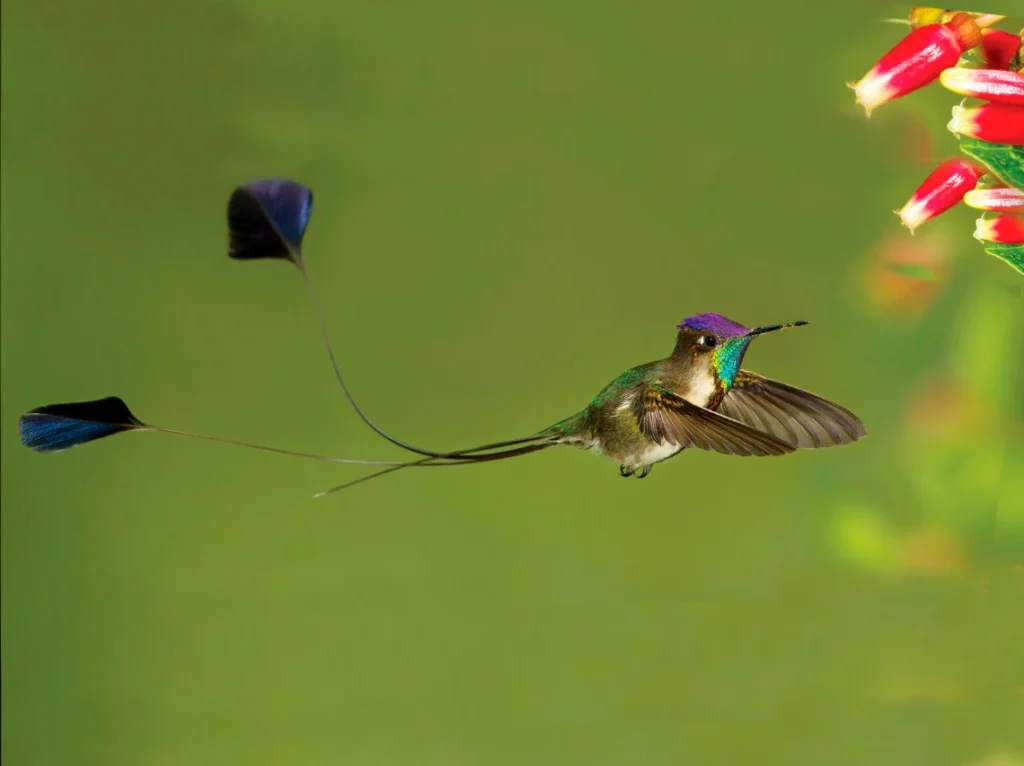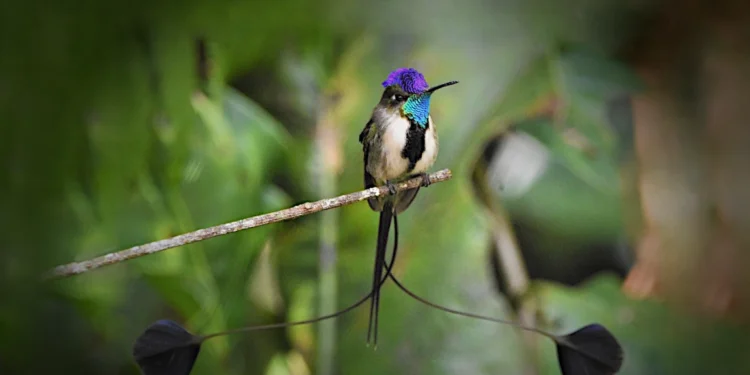This post is also available in:
Español
Nederlands
Among the clouded mountains of Peru, deep in the Andes, resides one of the most spectacular and exotic birds in the world: the sword-tailed hummingbird (Loddigesia mirabilis). Also known as the “wonder hummingbird,” this species is a visual spectacle that not only astonishes with its beauty but also with its fascinating characteristics. An exclusive treasure of Peru, it has captivated scientists and birdwatchers since its discovery in the 19th century. With its elegant racket-shaped tail and dazzling iridescent plumage, it’s hard not to be captivated by the beauty and uniqueness of this species. In this article, we will explore the most surprising features of this hummingbird, its habitat, and its essential role in the ecosystem.
A Bird That is Unique and Exclusive to Peru
The sword-tailed hummingbird is exclusive to certain regions of Peru, mainly in the cloud forests of the Upper Utcubamba Valley, located in the northeastern part of the country, in the provinces of Luya and Chachapoyas, in the southern part of the Amazonas department. Its habitat, at altitudes between 2,000 and 2,900 meters above sea level, provides a unique environment, filled with nectar-rich flowers essential for its feeding and pollination.
A Small Giant Wonder of Nature
Considered the smallest vertebrate animal, the hummingbird is a marvel of nature. Its size is astonishing: it measures about 15 cm in length and weighs between 40 and 70 grams. But don’t let its small size fool you; these birds are also very territorial and aggressive with other birds and species.
Hummingbirds are famous for their impressive flying abilities, and the sword-tailed hummingbird is no exception. These tiny birds are the only ones that can fly backward, allowing them to maneuver with great dexterity while searching for nectar in flowers. Additionally, they can remain stationary in the air, beating their wings up to 80 times per second.
Moreover, hummingbirds have exceptional vision. It has been discovered that they can see more colors than humans, detecting ultraviolet tones, which helps them locate the most nutritious flowers, which other animals can’t benefit from. Can you imagine how they see the world?

The Wonderful World of the Sword-tailed Hummingbird
The male sword-tailed hummingbird is particularly striking. With a bright turquoise forehead that changes color depending on the light, a white chest adorned with a black band, and wings of a brilliant copper color, there is no doubt that this is a unique species. However, its most impressive feature is its tail feathers: it has only four feathers in total, of which two are exceptionally long, racket-shaped, and end in large bluish-violet discs, known as “spatulas.” These feathers are not only beautiful but also play an essential role in mating rituals.
A Vital Role in the Ecosystem
The sword-tailed hummingbird stands out not only for its beauty but also for its incredible stamina. Its heart can beat up to 700 times per minute, enabling it to move rapidly between flowers and gather the nectar essential for its survival. This hummingbird is a crucial pollinator for its ecosystem: when feeding on plant nectar, pollen adheres to its feathers or beak, facilitating cross-pollination and contributing to the reproduction of plants in its environment.
The sword-tailed hummingbird is also known as the “wonder hummingbird.”
Discovery and Documentation
The sword-tailed hummingbird was first described in 1853 by British naturalist Andrew Matthews, who collected it for the famous bird collector George Loddiges, thus giving the species its scientific name, Loddigesia mirabilis. Since its discovery, this bird has captured the attention of naturalists and conservationists due to its rarity and astonishing morphology.
The Challenges of Survival
Although it is a spectacle of nature, the sword-tailed hummingbird faces several challenges. Its habitat is threatened by deforestation and the expansion of agriculture in the Peruvian Andes, which has significantly reduced its range of distribution. Moreover, its main predators include snakes, which pose a constant threat to these small birds.
Despite the challenges, the beauty and ecological value of the sword-tailed hummingbird have inspired conservation initiatives. Local and international organizations are working to protect its habitat in the cloud forests of the Andes. Natural reserves such as Abra Patricia in the Amazonas region play a crucial role in preserving this species.

A Symbol of Peru’s Natural Beauty
The sword-tailed hummingbird is not only a symbol of Peru’s biodiversity but also a reminder of the fragility of Andean ecosystems. This small yet majestic bird continues to amaze those who are fortunate enough to see it in its natural environment, and its conservation is vital to ensure that future generations can continue to admire it. If you ever have the chance to visit the cloud forests of northern Peru, you will be in one of the few places in the world where you might have the privilege of seeing this winged wonder in its natural habitat.
Did you find the beauty and uniqueness of the sword-tailed hummingbird surprising? Or have you ever seen this beautiful sword-tailed hummingbird? Share your own experiences with this wonderful bird, leave us a comment! We also encourage you to share this article on your social media and subscribe for more fascinating content about Peruvian biodiversity and curiosities.








